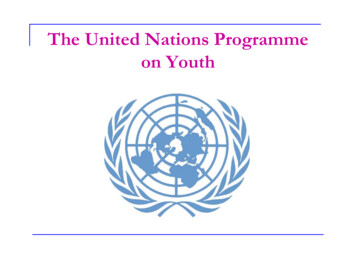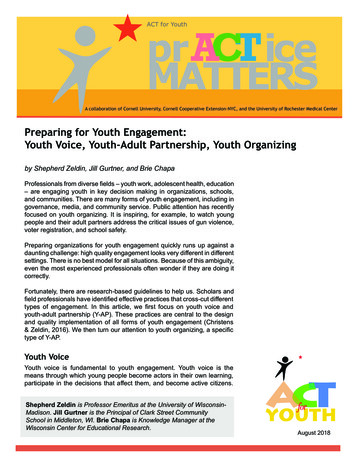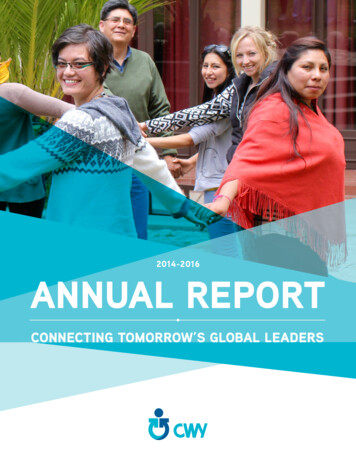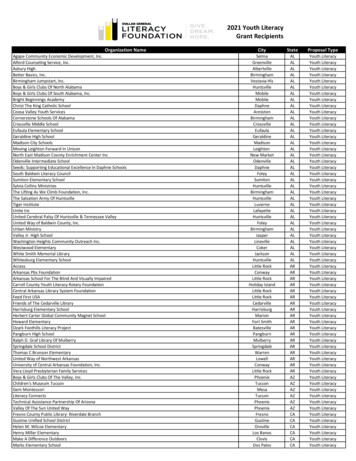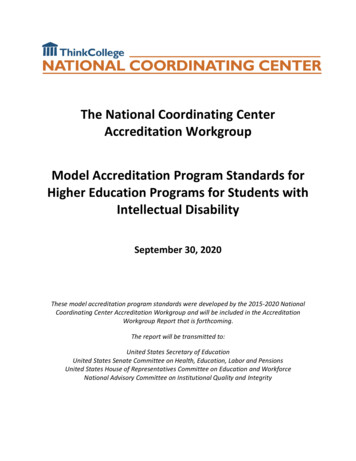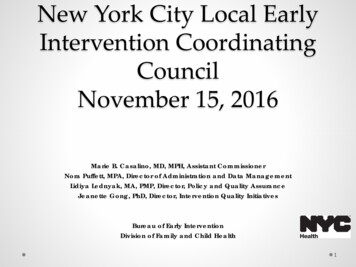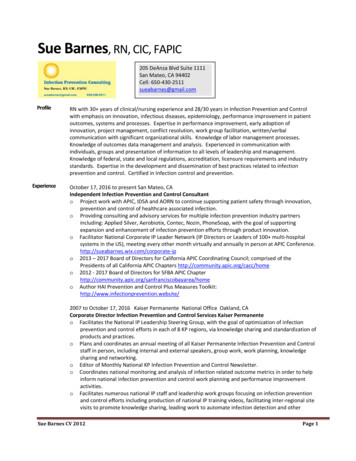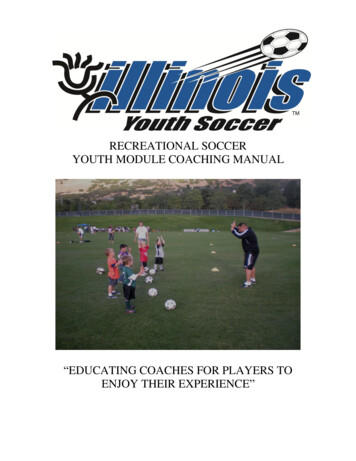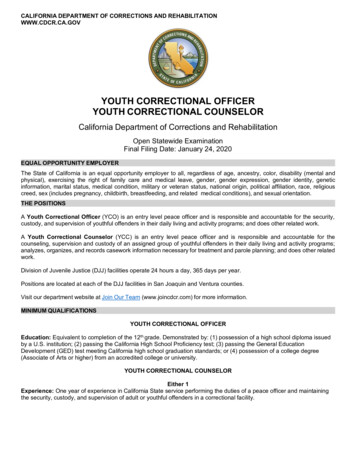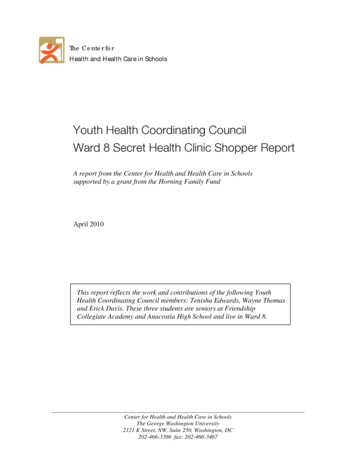
Transcription
The Center forHealth and Health Care in SchoolsYouth Health Coordinating CouncilWard 8 Secret Health Clinic Shopper ReportA report from the Center for Health and Health Care in Schoolssupported by a grant from the Horning Family FundApril 2010This report reflects the work and contributions of the following YouthHealth Coordinating Council members: Tenisha Edwards, Wayne Thomasand Erick Davis. These three students are seniors at FriendshipCollegiate Academy and Anacostia High School and live in Ward 8.Center for Health and Health Care in SchoolsThe George Washington University2121 K Street, NW, Suite 250, Washington, DC202-466-3396 fax: 202-466-3467
Youth Health Coordinating CouncilWard 8 Secret Health Clinic Shopper ReportThere are over 70,000 residents in Ward 8, the poorest area of Washington, DC and alongwith Ward 7, it’s most geographically remote. Approximately 36% of the Ward 8population consists of children and youth, 18 years or younger. Children in the Districtof Columbia are at greater risk for poorer health and life outcomes than children in otherparts of the United States. This is especially true in Ward 8, where poverty, violence, andpoor access to health and social services plague its residents. And despite the presence ofa variety of community based health facilities in Ward 8, the adolescent health dataindicates that something more or different is needed to address teen health needs andaccess to care. (Every Kid Counts in the District of Columbia 16th Annual Fact Book2009).The project.Through the generous support and funding of the Horning Family Foundation, the Centerfor Health and Health Care in Schools at the George Washington University School ofPublic Health and Health Services has engaged young people from Ward 8 to be part of aYouth Health Coordinating Council (YHCC). The role of the YHCC has been to discussand research the health issues that most concern young people in Ward 8 and to identifyavailable community health resources that might respond to these issues. Where barriersand challenges are identified, the project would propose solutions and action plans tomake Ward 8 health resources stronger and more youth accessible. As part of its efforts,the YHCC planned to present these concerns and solutions to policymakers and providerswith the goal of improving teen access to health services in Ward 8.The YHCC has undertaken several activities in the past year. The students identified theunmet health needs of teens in Ward 8: they identified existing community healthservices and reviewed their web sides, and developed the key criteria that they believemake health services more “teen friendly.”Community clinics in Ward 8.Seven health clinics are listed on the Internet as primary health centers in Ward 8. Theseinclude:Anacostia Community Health Center at 1328 W Street, SECongress Heights Clinic at 3720 Martin Luther King Jr. Ave, SEStanton Road Health Center at 3240 Stanton Road, SEWoodland Terrace Health Clinic at 2041 Martin Luther King, Jr. Ave, SEFamily and Medical Counseling at 2041 Martin Luther King, Jr. Ave, SEChildren’s Health Center – Good Hope Road at 2501 Good Hope Road, SEBallou Senior High School Health Center 3401 4th Street, SECenter for Health and health Care in Schools l www.healthinschools.org2
The students' web site review found that of these seven centers few provide informationon hours available, services offered, financial/payment information, confidentialitypolicy, HIV/STI testing, walk-in versus appointment policies and hours, and access tobus or subway service. Where information is presented it is difficult to understand or notrelevant to adolescents. For example, the limited financial information makes obliquereferences to sliding scale fees and family size; services do not include specific referenceto teen-focused services, and the service hours (walk in/acute care visits versusappointments for health visits) are unclear. The Family and Medical Counseling HealthCenter web site is under construction and was not available for review. Ballou SeniorHigh School Based Health Center is currently not open for services and does not have anactive web site.YHCC Secret Health Shopping Report.An important activity of YHCC this winter was the development of a “secret health clinicshopper” project to evaluate the accessibility of Ward 8 health centers to area teens. TheYHCC members developed a phone call script that began with a request to make anappointment with a doctor for a sports physical after school hours and followed up withquestions about hours, services, payment, confidentiality and proximity of the center tomass transit.The students called the targeted clinics on two separate days and at different times of theday. The first set of phone calls were made in the late afternoon (between 4 and 4:45,after school hours) and the second set of calls to the same centers a week later wereplaced in the late morning/early afternoon. Both days and times they placed calls to thehealth center numbers listed.During the first set of calls (after school), the students dialed all seven listed centers: nocalls were answered and the recorded messages for the centers stated that calls forappointments would not be taken after 4pm.During the second set of calls, calls were made during late morning and early afternoon.Despite these earlier call times, the teens were still unable to make an appointment orhave their questions answered. The reasons for their lack of success included: A confusing and overloaded centralized appointment call system for 4 of theseven centers with a wait for 60 - 90 minutes on hold before the call wasansweredWhen their call into the centralized appointment line was finally answered, theywere required to identify a physician in order to make an appointment (they didnot have a doctor so were unable to proceed with appointment process)The centralized appointment person could not provide specific information aboutthe health centers.In the two health centers where students were successful in reaching a staff member, thepersons answering the phone were unable to answer many of the questions asked. One ofthe few pieces of information the YHCC teens were told about four of the seven healthcenters was there were no appointments for routine health exams available after schoolCenter for Health and health Care in Schools l www.healthinschools.org3
hours (evenings or weekends) and routine health exams were only available starting at 8am with the last scheduled appointment of the day at 3 pm. In one instance, a teen wasasked what his insurance coverage was. When that teen said he did not have insuranceand asked about the cost if he did not have insurance, he was told the cost of a physicalexam would be between 200 - 300.Reflections on Ward 8 Secret Shopping Experience and Follow-Up.Given the enormous health concerns for the teens in Ward 8 and in Washington DC, thissecret shopper experience was surprising, alarming and as one of the YHCC members putit "demoralizing". These health centers may offer many services of value to teens inWard 8 but they are not teen accessible in the two most common ways teens access them:their cell phones and the web.As part of their experience on the YHCC, the teens are sharing their findings, concernsand recommendations to DC policy makers and providers in the hope that thisinformation and insight will prompt improvements in teen access to health care in Ward8. Meetings with DC Council members have been scheduled. YHCC members will usethese meetings not only to report their findings and share their ideas for solutions but alsoto learn more about the role of the DC Council in setting policy and making investmentsin communities. DC Council members responding to requests for meetings includeCouncil Chairman Vincent C, Gray, Ward 8 Councilmember Marion Barry, and At-LargeCouncilmember and Chair of the Health Committee David Catania.The YHCC also contacted Unity Health Care, the federally qualified health center thatoperates four of the seven health centers called by the students. Unity Health invited thestudents to meet with the Anacostia Health Clinic manager. During the meeting,members of the YHCC reported on their experience and heard from her about the fullrange of services available. Although the array of services was great, YHCC memberspointed out that teens do not know these are available and that currently there are nomechanisms for outreach to teens. The students shared their thoughts on what the clinicmight do to make itself more accessible to the teens. Their suggestions included betterinformation on the web site, complete hours of operation including when to call for anappointment, on-line appointment capacity, more understandable information on how topay for services, lists of services teen are looking for such as HIV and STI testing,information on confidentiality of services, access to metro and bus routes, a teen hot lineto call for questions and information, a teen advisory group to help make centers moreteen friendly, and better ways to outreach to the teen community.The young people who have been a part of the YHCC are preparing to graduate fromhigh school and move on to the next phase of their lives. They have shown bothdedication and commitment to this project and made an immense contribution toimproving teen accessible health care in their community. The Horning Family Fundsupport for the project is also due to end June 30, 2010. The Center for Health andHealth Care in Schools plans to seek future funding opportunities to continue this workwith teens of DC around making health care more accessible. It is hoped that futurefunding would both build on the success of the YHCC’s current work and to supportsimilar projects that involve young people in creating a more teen friendly health careCenter for Health and health Care in Schools l www.healthinschools.org4
system and better health outcomes in DC. Finally, as Unity Health Care prepares tobreak ground on their new health center in Ward 8, a teen advisory group such as theYHCC could play a vital role in ensuring the new space and service delivery better meettheir needs.------------------This report was prepared by Donna Behrens, Associate Director at the Center for Healthand Health Care in Schools on behalf of the YHCC members who participated in theSecret Shopper project: Tenisha Edwards, Wayne Thomas and Erick Davis. All threeare residents of Ward 8 and are seniors in high school at Friendship Public CharterSchool.Center for Health and health Care in Schools l www.healthinschools.org5
Center for Health and Health Care in Schools The George Washington University 2121 K Street, NW, Suite 250, Washington, DC 202-466-3396 fax: 202-466-3467
